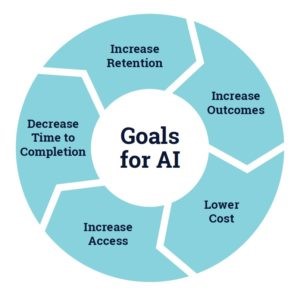4. Emerging Technologies: Artificial Intelligence
4.3. Why Use Artificial Intelligence for Teaching and Learning?
There are two somewhat different goals for the general use of artificial intelligence. The first is to increase the efficiency of a system or organization, primarily by reducing the high costs of labour, namely by replacing relatively expensive human workers with relatively less costly machines (automation). In education in particular, the main cost is that of teachers and instructors. Politicians, entrepreneurs and policy makers increasingly see a move to automation as a way of reducing the costs of education.
The second is to increase the effectiveness of teaching and learning, in economic terms to increase outputs: better learning outcomes and greater benefits for the same or more cost. With this goal, AI would be used alongside or supporting teachers and instructors.
Klutka et al. (2018) provide a general statement of the potential of AI in higher education ‘instruction’ through Figure below.

These are understandable goals, but we shall see later in this section that such goals to the date is mainly aspirational rather than real.
In terms of this book, a key focus is on developing the knowledge and skills required by learners in a digital age. The key test then for artificial intelligence is to what extent it can assist in the development of these higher-level skills.
